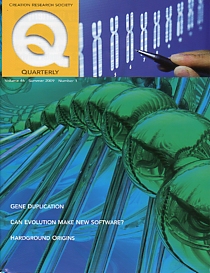 by John Woodmorappe
by John Woodmorappe
CRS Quarterly, Volume 46, Number 1,
Summer 2009, pp. 7-14.
Abstract:
Transport processes can potentially account for in situ hardgrounds in the sedimentary record. Steadily accumulating evidence undermines the certitude of life-position inferences of at least certain fossils. Some turbidity currents and debris fl ows allow for the contemplation of large-scale transport, imbrication, and coplanar deposition of large, flat slabs of antediluvian hardground origin. Modern volcanoes demonstrate that released gas can cause the flotation of large rock slabs. Finally, many in situ hardgrounds show evidences at least suggestive of a composite, allochthonous origin. A hardground-conduit hypothesis posits that hardgrounds formed in pseudokarstic-submarine (underwater cavelike) structures. This solves the apparent problems of time and stratigraphically superposed hardgrounds. The hardiness of hardground organisms is just one factor consistent with this hypothesis.

